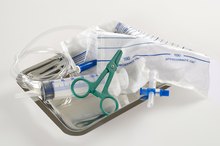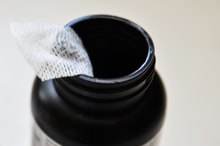Collection by Masturbation
The most common method of sperm collection for semen analysis or insemination is self-collection by masturbation and ejaculation into a sterile collection cup. Typically, the patient is given a clean private area that is stocked with erotic videotapes and magazines to assist with arousal. A similar non-medical approach for semen collection is the use of a collection condom with the patient's partner. The collection condom is worn by the patient during sexual intercourse to collect the ejaculate. Collection condoms may be preferred when masturbation is not socially acceptable to the patient. Unlike condoms used for birth control, collection condoms don't contain spermicide and are made from non-latex, sperm-safe plastics.
If you are experiencing serious medical symptoms, seek emergency treatment immediately.
- The most common method of sperm collection for semen analysis or insemination is self-collection by masturbation and ejaculation into a sterile collection cup.
- A similar non-medical approach for semen collection is the use of a collection condom with the patient's partner.
Collection by Electroejaculation
What Causes Ejaculation?
Learn More
In some patients who have suffered a spinal cord injury, ejaculation by masturbation or intercourse using a collection condom are not options for sperm collection. In this case, the ejaculatory nerves can be electrically stimulated using a rectal probe with electrodes. This low-voltage stimulation is usually sufficient to produce a semen ejaculate, although the quality of the ejaculate is often less using this method compared to masturbation. This procedure usually occurs in an operating room and is performed by a urologist who is assisted by nursing staff. Due to the innate lack of sensation from the spinal injury, anesthesia is not always required in these cases, but may be used for the emotional comfort of the patient.
- In some patients who have suffered a spinal cord injury, ejaculation by masturbation or intercourse using a collection condom are not options for sperm collection.
- This low-voltage stimulation is usually sufficient to produce a semen ejaculate, although the quality of the ejaculate is often less using this method compared to masturbation.
Collection by Microepididymal Sperm Aspiration (MESA)
Microepididymal sperm aspiration (MESA) is a surgical approach for collection of sperm when the ejaculatory tubes (ducts) are blocked or have been interrupted by a previous vasectomy. The epididymis is a coiled segment of sperm ducts that lies on the upper surface of the testis. Sperm is produced in the testis but must transit through the three regions of the epididymis to acquire its full ability to swim and to achieve full fertility function. A surgical incision is made into the outer covering of the testis, and the epididymis is exposed under anesthesia in an operating room. Using a surgical microscope, the urologist can visualize areas of the epididymis to identify expanded areas of the duct likely to contain sperm. An incision is made in these sperm ducts, and the sperm is gently extracted. Percutaneous epididymal sperm aspiration (PESA) is a variant of this approach, using a sterile needle to aspirate (suction) sperm from the epididymis. PESA can be performed under local anesthesia, but less sperm is collected using this approach. Also, the site of collection is more random (stab the epididymis and hope to find sperm). Both approaches typically yield enough sperm for use with assisted reproductive methods such as sperm injection and in-vitro fertilization, but not enough for a standard insemination.
- Microepididymal sperm aspiration (MESA) is a surgical approach for collection of sperm when the ejaculatory tubes (ducts) are blocked or have been interrupted by a previous vasectomy.
- Percutaneous epididymal sperm aspiration (PESA) is a variant of this approach, using a sterile needle to aspirate (suction) sperm from the epididymis.
Collection by Testicular Sperm Extraction (TESE)
Symptoms After Prostate Biopsy
Learn More
For men who produce extremely small numbers of sperm, recovery of sperm from the epididymis may not be successful. Testicular extraction and possibly tissue removal (biopsy) may be the best option for collecting sperm suitable for assisted reproductive techniques. TESE is a surgical procedure performed under anesthesia in an operating room. The outer covering of the testicle is pulled back so that seminiferous tubules containing sperm can be visualized. An enlarged tubule is gently cut to permit sperm to flow from the tubule, where it can be aspirated using a sterile needle. Sometimes, to collect enough sperm, a piece of testicular tissue may have to be removed (biopsied). In the laboratory, under sterile conditions, the small piece of testicular tissue is carefully pulled apart into tiny fragments in a culture dish. Sperm released from the opened seminiferous tubules into the culture dish are collected for use in assisted reproductive technology techniques.
- For men who produce extremely small numbers of sperm, recovery of sperm from the epididymis may not be successful.
- In the laboratory, under sterile conditions, the small piece of testicular tissue is carefully pulled apart into tiny fragments in a culture dish.
Related Articles
References
- Sullivan R, Mieusset R. The human epididymis: its function in sperm maturation, Hum Reprod Update. 2016;22(5):574-87. doi:10.1093/humupd/dmw015
- Redshaw JD, Tran TL, Wallis MC, Devries CR. Epididymitis: a 21-year retrospective review of presentations to an outpatient urology clinic. J Urol. 2014;192(4):1203-7. doi:10.1016/j.juro.2014.04.002
- Frungieri MB, Calandra RS, Bartke A, Matzkin ME. Ageing and inflammation in the male reproductive tract. Andrologia. 2018;50(11):e13034. doi:10.1111/and.13034
- Mcdonald SW. Vasectomy review: sequelae in the human epididymis and ductus deferens. Clin Anat. 1996;9(5):337-42. doi:10.1002/(SICI)1098-2353(1996)9:5<337::AID-CA7>3.0.CO;2-9
- Bedford JM. The epididymis re-visited: a personal view. Asian J Androl. 2015;17(5):693-8. doi:10.4103/1008-682X.153297
- Domeniconi RF, Souza AC, Xu B, Washington AM, Hinton BT. Is the epididymis a series of organs placed side by side?. Biol Reprod. 2016;95(1):10. doi:10.1095/biolreprod.116.138768
- Turner TT. De Graaf's thread: The human epididymis. J Androl. 2008;29(3):237-50. doi:10.2164/jandrol.107.004119
Writer Bio
Carole Wegner is a Ph.D. scientist and in-vitro fertilization lab director in the Midwest. For more than 20 years, she has published scientific findings in peer-reviewed journals such as "Endocrinology" and "Fertility & Sterility" and also written on the topic of ethics in reproductive medicine.









